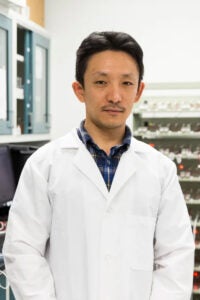University of Central Florida researchers have achieved new record-setting power density for ethanol fuel cells, helping advance the technology as a competitor to fossil fuels and electric car batteries.
Ethanol fuel cells offer cleaner emissions than fossil fuels and no charging times compared to electric vehicle batteries.
In recent studies published in the journals Nature Communications and Joule, UCF NanoScience Technology Center Associate Professor Yang Yang and his team developed new catalysts to make direct ethanol fuel cells last longer and boost their power density to a record level.
Biomass-derived ethanol has been widely used in many industries, including as a liquid biofuel. However, the ethanol must go through a conversion process to become usable fuel and can only be indirectly converted to energy by blending with gasoline to achieve an acceptable conversion efficiency.

Direct ethanol fuel cells, unlike the traditional ways to use ethanol, allow for ethanol to be directly poured in and used for fuel that can be directly converted into electricity at high efficiency. The alcohol-based power source could be used to power vehicles and create nearly noise-less electric power generators, which could benefit both defense and residential usage.
The greater power density of the direct ethanol fuel cells developed in Yang’s lab means more power can be delivered using less space, which is key for practical applications like in vehicles where compact and low-weight power sources lead to more efficient travel.
“Our research enables direct ethanol fuel cells to compete with hydrogen-fuel cells and batteries in various sustainable energy fields, which have not yet been achieved before our invention,” Yang says. “Ethanol is a clean and safe biofuel in the liquid phase, which is much easier and safer for storage and transport than pure hydrogen. Compared to the technology to extract hydrogen from ethanol and then convert hydrogen to electricity, our technology can directly convert ethanol into electricity, so it is an overall positive energy balance and negative emission technology.”
About the Studies
Nature Communications
In this work, the researchers developed a new materials design principle based on the synergistic interface effect in which the combination of different materials leads to enhanced performance beyond the individual components.
For the design, the researchers used active palladium nanoparticles semi-embedded into graphitic shells, which were covered on the surface of cobalt nanoparticles, forming a unique palladium and cobalt nitrogen-graphite carbon structure.
When tested as both a positive electrode (cathode) and negative electrode (anode) catalyst, the structure delivered increased power density and stable operation for more than 1,000 hours, far exceeding current, commercial palladium carbon and other state-of-the-art catalysts, Yang says.
Joule
In this study, the researchers achieved a power density of almost 0.8 watts per square centimeter using a new high-entropy alloy catalyst they designed, setting a new performance record.
The catalyst can be used for both the cathode and anode to overcome challenges with sluggish reactions and high energy needs.
“The results really break the record by enhancing the fuel cell performance by a few folds compared to commercial catalysts,” Yang says.
Next Steps
Yang says the research team is working to further improve the power density of the direct ethanol fuel cells by optimizing the composition of the catalysts and is also exploring ways to commercialize the technology.
Researcher Credentials
Yang holds joint appointments in UCF’s NanoScience Technology Center and the Department of Materials Science and Engineering, which is part of the university’s College of Engineering and Computer Science. He is a member of UCF’s Renewable Energy and Chemical Transformation (REACT) Cluster. He also holds a secondary joint-appointment in UCF’s Department of Chemistry and The Stephen W. Hawking Center for Microgravity Research and Education. Before joining UCF in 2015, he was a postdoctoral fellow at Rice University and an Alexander von Humboldt Fellow at the University of Erlangen-Nuremberg in Germany. He received his doctorate in materials science from Tsinghua University in China.




